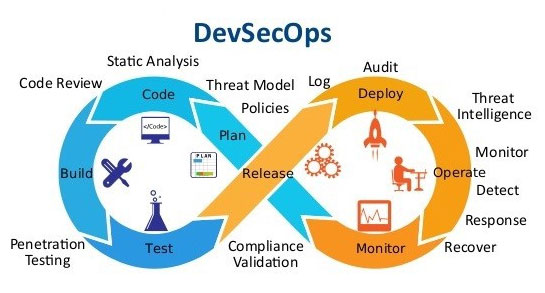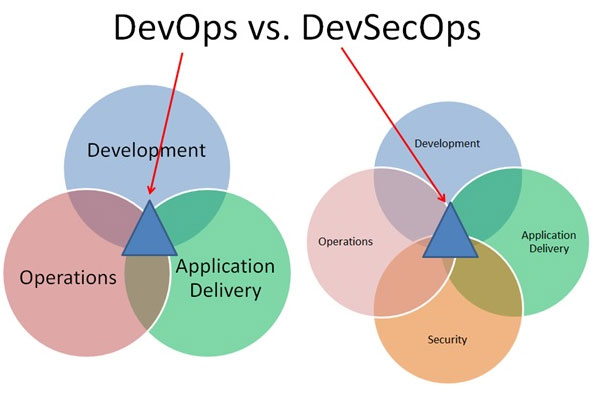DevOps and SecOps are two of the most important fields in today’s software industry. They come together to form a new hybrid called DevSecOps that is gaining significant traction. Despite being around for some time, the adoption of DevOps and SecOps has accelerated over the past few years. However, both these practices still have their limitations. The need for addressing cyber security risks proactively and integrating security in software development cycles of DevOps led to the emergence of a new paradigm called ‘DevSecOps’. Let’s take a look at what it means and how it can help your organization succeed with DevOps and cyber security at the same time
What Is DevSecOps?
DevSecOps (aka, DevOps with Security) is the combination of DevOps and SecOps practices. It aims to solve the current challenges of security in software development by integrating security in DevOps processes and tools. The goal of DevSecOps is to automate and orchestrate security across the software development lifecycle (SDLC). To accomplish this, DevOps and SecOps processes, tools, and practices are combined to create a comprehensive approach to software development enabling organizations to succeed with DevOps and cyber security at the same time. A comprehensive DevSecOps solution acts as a single source of truth for security reviews and vulnerabilities across the entire software development lifecycle and helps companies achieve the following objectives: – Deliver software faster with increased visibility and traceability across the entire software development lifecycle from Dev to Ops – Reduce time to remediate vulnerabilities by automating the process and providing guidance across the entire software development lifecycle – Enable compliance and improve security by adding security controls in the SDLC and leveraging automation and orchestration – Drive organizational change and establish a culture of security by incorporating security in the DevOps culture and tools
Overview of the DevOps Framework
The DevOps framework is an agile methodology that combines the best practices of software development and engineering with the best practices of IT operations. It aims to achieve continuous improvement, increase visibility, and improve collaboration between these two disciplines. The core of the DevOps framework is an underlying philosophy that unifies the two disciplines. This is achieved by five key principles: – Autonomy: Self-organizing teams that have the authority to choose the best tools, technologies, and workflows to meet their objectives. – Focus on Customers: Continuous communication between the teams and customers using feedback loops to understand their needs and ensure the teams are meeting their expectations. – Cultural Transformation: Cultural change to enable the two disciplines to work together to achieve their objectives and be successful. – Improvement: Establishing a feedback loop to understand how successful the implementation has been, what went well, and what can be improved on.

Benefits of the DevOps Framework
– Improved Collaboration: A holistic and organization-wide approach to problem solving and decision making that promotes collaboration between software development and IT operations. – Improved Visibility: Visualization tools such as Kanban boards, issue tracking, and compliance dashboards help with increasing visibility across the organization. – Increased Productivity: Focus on implementing practices and tools that help the organization work more efficiently. – Reduced Cycle Time: The two disciplines working together to solve one problem at a time instead of focusing on individual problems. – Reduced Time to Market: The two disciplines working together to get their work done as quickly as possible.

Source: https://commons.wikimedia.org/
Limitations of the DevOps Framework
Although the DevOps framework is a great practice for software development, it doesn’t account for security risks and compliance issues that can arise through the lifecycle. The traditional model of software development has security controls embedded in the design and architecture of software. However, these controls are often overlooked in the development cycle. This can lead to security risks and compliance issues. The DevOps model doesn’t account for regulatory compliance either. It focuses on improving collaboration between software development and IT operations. It doesn’t account for the different regulatory and compliance requirements that govern organizations.
Key Takeaway
The DevOps model has helped organizations improve collaboration between software development and IT operations. However, it doesn’t account for security risks and compliance issues that can arise from these disciplines working together. The DevOps model can be improved if the two disciplines work together to solve a single problem at a time without complicating it by adding unnecessary tasks. Another way to improve the DevOps model is to embed security controls in the design and architecture of software. This ensures that security risks and compliance issues are addressed upfront. The DevSecOps model aims to solve these issues by bringing together the best practices of DevOps and SecOps to create a comprehensive approach to software development.
Reference
https://owasp.org/www-project-devsecops-maturity-model/
https://www.redhat.com/en/resources/deploy-comprehensive-devsecops-solution-overview
https://www.researchgate.net/publication/319633880_DevSecOps_A_Multivocal_Literature_Review
https://www.gitguardian.com/whitepapers/devsecops













